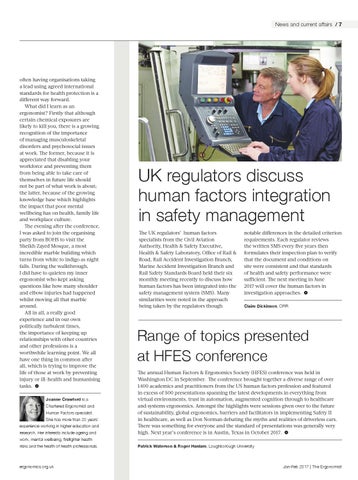News and current affairs / 7
often having organisations taking a lead using agreed international standards for health protection is a different way forward. What did I learn as an ergonomist? Firstly that although certain chemical exposures are likely to kill you, there is a growing recognition of the importance of managing musculoskeletal disorders and psychosocial issues at work. The former, because it is appreciated that disabling your workforce and preventing them from being able to take care of themselves in future life should not be part of what work is about; the latter, because of the growing knowledge base which highlights the impact that poor mental wellbeing has on health, family life and workplace culture. The evening after the conference, I was asked to join the organising party from BOHS to visit the Sheikh Zayed Mosque, a most incredible marble building which turns from white to indigo as night falls. During the walkthrough, I did have to quieten my inner ergonomist who kept asking questions like how many shoulder and elbow injuries had happened whilst moving all that marble around. All in all, a really good experience and in our own politically turbulent times, the importance of keeping up relationships with other countries and other professions is a worthwhile learning point. We all have one thing in common after all, which is trying to improve the life of those at work by preventing injury or ill-health and humanising tasks. • Joanne Crawford is a Chartered Ergonomist and Human Factors specialist. She has more than 20 years’ experience working in higher education and research. Her interests include ageing and
UK regulators discuss human factors integration in safety management The UK regulators’ human factors specialists from the Civil Aviation Authority, Health & Safety Executive, Health & Safety Laboratory, Office of Rail & Road, Rail Accident Investigation Branch, Marine Accident Investigation Branch and Rail Safety Standards Board held their six monthly meeting recently to discuss how human factors has been integrated into the safety management system (SMS). Many similarities were noted in the approach being taken by the regulators though
notable differences in the detailed criterion requirements. Each regulator reviews the written SMS every five years then formulates their inspection plan to verify that the document and conditions on site were consistent and that standards of health and safety performance were sufficient. The next meeting in June 2017 will cover the human factors in investigation approaches. • Claire Dickinson, ORR
Range of topics presented at HFES conference The annual Human Factors & Ergonomics Society (HFES) conference was held in Washington DC in September. The conference brought together a diverse range of over 1400 academics and practitioners from the US human factors profession and featured in excess of 500 presentations spanning the latest developments in everything from virtual environments, trust in automation, augmented cognition through to healthcare and systems ergonomics. Amongst the highlights were sessions given over to the future of sustainability, global ergonomics, barriers and facilitators in implementing Safety II in healthcare, as well as Don Norman debating the myths and realities of driverless cars. There was something for everyone and the standard of presentations was generally very high. Next year’s conference is in Austin, Texas in October 2017. •
work, mental wellbeing, firefighter health risks and the health of health professionals.
ergonomics.org.uk
Occ.Health__The Ergonomist 7
Patrick Waterson & Roger Haslam, Loughborough University
Jan-Feb 2017 | The Ergonomist
13/12/2016 12:56
